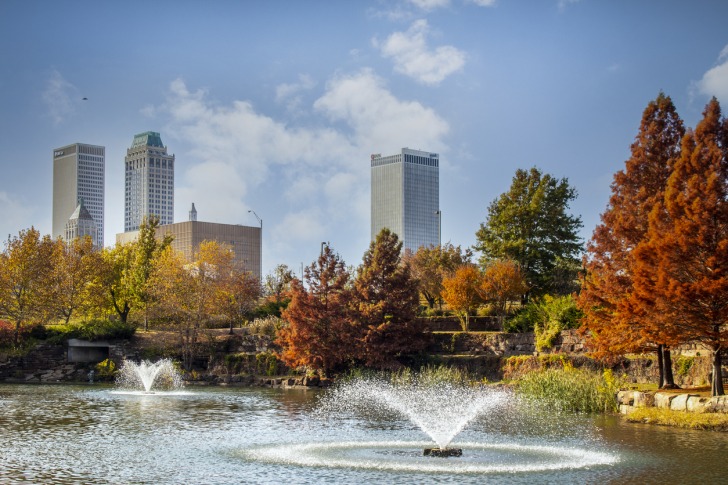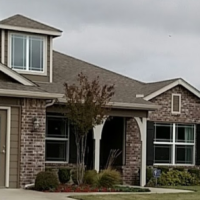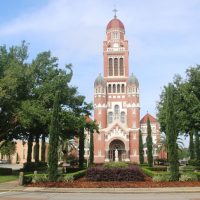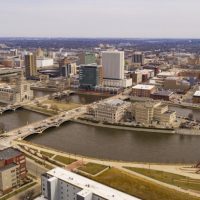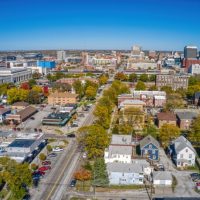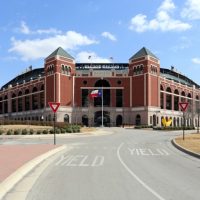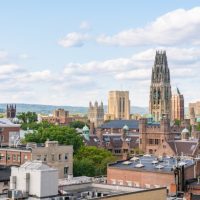Tulsa, Oklahoma, is a vibrant city that has grown well beyond its oil-drilling toots.
A food-lovers destination, Tulsa is also known for its dynamic art scene with nine museums and boasting impressive art deco architecture.
Centered in the Deco District, the city’s collection of buildings is one of the largest in the country, including over a dozen structures on the National Historic Register.
The largest employers in the area are education, aerospace, defense technologies, and medicine.
The Sooner State’s second-largest city, roughly 410,000 people, has a storied history full of cowboys and roughnecks.
It began as an early 19th-century settlement derived from the relocation of the Lochapoka Band of Creek from Georgia and Alabama.
Forged near the Arkansas River, the city was home to traders and farmers but found its footing with the arrival of the St. Louis and San Francisco Railroad in 1882.
Tulsa is an important stop on Route 66, claiming 28 miles of the famed east-west national corridor.
It sits 106 miles northeast of Oklahoma City and roughly 250 miles north of Dallas, Texas.
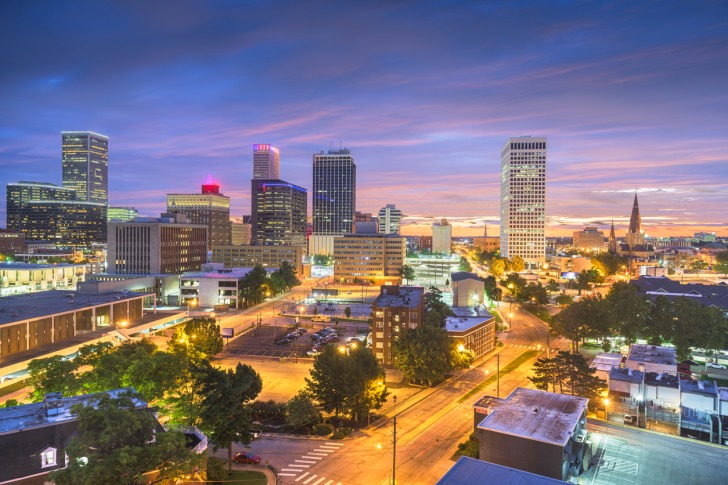
Contents
Pros of Living in Tulsa
1. Mid-Size Charm
Tulsa is a quintessential western oil-boom town surrounded by forests, green hills, and Native American land.
Well-known as a place of 410,000, its growing Metroplex serves over 1 million.
2. Diverse Cultures
Throughout the area, there is a rich blending of numerous cultures visible in the city’s food, music, and traditions.
Tulsa’s residents are the reason this 201-square-mile community is rated as one of the most diverse communities in the nation.
3. Low Cost of Living
The cost of living in Tulsa is slightly higher than most of the Sooner State – 3%.
But the city is affordable by national standards, some 11% lower than the national average.
The vast majority of living costs are food and transportation.
Tulsa’s housing and utilities, when compared to the national average, are 22% and 6% cheaper, respectively.
Tulsa has an integrated public transportation system – buses and a downtown trolley system.
Many districts and neighborhoods are served, and most residents have a personal vehicle.
4. Artistic Hotspot
Tulsa has a rich creative community with over 25 private and public museums, including the Philbrook Museum of Art, the Oklahoma Jazz Hall of Fame, DECOPOLIS Tulsa Art Deco Museum, and the Richardson Asian Art Museum.
For a bit of eclectic fun, the city is also home to the Vintage Sewing Machine Museum and the Bob Dyan Center.
Downtown is a mish-mash of districts.
Tulsa Performing Arts Center sits in the heart of the Deco District.
Music venues and galleries line the Tulsa Arts District. Blue Dome District is home to bars and clubs.
5. Festivals and Music
Tulsa celebrates throughout the year with food, cultural, and music jams.
From marathons to Mayfest, festivals unite this community.
One of the most well-known gatherings is the Tulsa Octoberfest.
The Tulsa State Fair is a family-friendly event.
The Tulsa’s Festival Americas highlights Hispanic and Latino cultures.
During winter, the city celebrates the season with a 9,000-square-foot ice skating rink, Christmas trees, and sparkling lights during Winterfest.
6. Outdoor Activities
Famed for its parks and outdoor culture, Tulsa’s The Gathering Place was named USA Today’s “Best New Attraction to Visit (2019).”
An immense 66-acre park on the Arkansas River is complete with splash pads, sports courts, hike and bike trails, and a skate park.
In total, Tulsa is home to 135 parks and over 111 miles of outdoor adventure trails.
7. Advanced Education
Tulsa is home to nine post-secondary institutions, including one public and seven private universities, four of which have been ranked by U.S. News and World Reports as ‘Best Colleges.’
There is also one community college and about a dozen vocational colleges offering specialized education in welding, health services, and aircraft maintenance.
Tulsa has also been given high marks for its primary and secondary schools, with 69 in its public system.
8. Employment Options
Tulsa was once known as the ‘Oil Capital of the World,’ and energy production is still a strong employer.
But, the areas of healthcare and aerospace are also growing.
Some of Tulsa’s largest employers are Saint Francis and Hillcrest Health Systems, Tulsa Public Schools, Walmart, American Airlines, various universities, and the City of Tulsa.
9. Slower Pace
The pace of Tulsa is decidedly slower than nearby metropolitan hubs such as Dallas or St. Louis.
For many in Tulsa, this relaxed pace is preferred, allowing ample time for art, the outdoors, and family.
10. Flavorful Delights
Tulsa is known for a special kind of barbecue with dozens of family-owned options.
But the city is not just about smoked meats.
Food trucks serve a thriving street scene within comfort food, and hearty breakfast diners are Tulsa staples.
The city is also home to craft breweries and pubs and a variety of international fusion restaurants.
Tulsa is a tight-knit family community.
Surprisingly cosmopolitan, there remains a tinge of the Wild West.
But, the city has some drawbacks.
If changeable weather and fewer shopping options are a dealbreaker, other larger cities may be preferred.
Cons of Living in Tulsa
1. Small Town
Roughly 410,000 people call Tulsa home.
And the city is growing by roughly 1.2% each year.
The metropolitan area, which includes Tulsa’s suburbs, is growing at a faster rate than the city.
For many looking to downsize, Tulsa offers many amenities but a slower life pace and is considered one of the country’s “best places to retire.”
Forbes ranked the city ‘one of the best 25 places to retire in the United States.’
2. Concerning Crime
Tulsa has a notable crime rate, higher than its nearby neighbor of Oklahoma City.
Because crime trends can change significantly, it is also recommended to research an area for safety.
Violent crime rates in Tusla make it the 3rd most dangerous city in Oklahoma, with property crime ranking as the fourth in the state.
Overall, there is a 1 in 192 chance of encountering a violent crime.
Slightly lower, the property crime rate was – a 1 in 20 probability of property damage.
Overall, Tulsa’s crime rates are roughly two times worse than the state’s average.
3. Economic Diversity
The local economy has been historically tied to the oil and gas industry.
Job opportunities within these sectors require specialized knowledge and skilled training.
It’s a bust for those with generalized education.
However, Tulsa’s continued growth has also brought with it an expansion of job opportunities such as healthcare, education, aerospace and defense manufacturing, and aircraft maintenance; with this growth, service sectors are also expanding.
4. Weather
Tulsa is famous for its extreme weather – think Dorothy and the “Wizard of Oz.”
But not every day is filled with tornados.
The average snowfall in Tulsa is 10 inches.
Summer days see only a handful of highs near 100, and winter lows average around freezing.
The highest temperature recorded in the area was in 1936 when the outside thermometers reached 120.
Earthquakes are common in the area but rarely go above 2.0.
5. Taxes
Tulsa’s property and city sales taxes vary.
The city has a sales tax rate of 8.5%, similar to many Texas cities.
The county’s property and other tax rates are tiered – hovering around 2%.
The state of Oklahoma also has a graduated individual income tax, from .25% to 4.5%.
There is also a 4% corporate income tax.
6. Limited Healthcare Specialization
The healthcare profession is rapidly growing in Tulsa.
The two major medical systems of Hillcrest and St. Francis serve most of the population.
Some specialized care is prominent in the area, but most advanced medical treatment still requires travel.
7. Public Services
Public transportation in Tulsa is notable.
The numerous universities in the area have designated bus routes and bike lanes.
Trolley routes serve downtown and the arts districts, but riders have limited access to suburban areas.
Limited routes make owning a vehicle or bicycle in Tulsa a necessity.
On a positive note, downtown Tulsa has, at last count, over a half dozen charging stations for bikes and electric vehicles.
8. Traffic Congestion
Tulsa’s size works in its favor when it comes to traffic.
But commuters still encounter traffic during peak periods, both morning and evening.
Considering that car ownership in the city is on par with the national average of two cars per household, the 22-minute commute time is reasonable.
9. Air Quality
Tulsa has a history of air quality issues due to geography, heat, humidity, and the manufacturing industry.
There has been a marked improvement within the past decade, but certain conditions can create breathing issues with older adults or individuals with respiratory conditions.
10. Slower Pace
Both a pro and a con, there is no doubt that life runs a little slower in Tulsa than in larger cities throughout the Midwest.
For those who crave the electricity and excitement of a large metropolis or expect 24-hour-a-day services, Tulsa’s graduated pace may prove difficult to bear.
It is always hard to choose the perfect place to live, attend school, and or work.
For the most part, the choice is a gentle balancing act between priorities.
So, with a bit of effort, weighing the pros and cons of living in Tulsa, one can find the perfect fit.
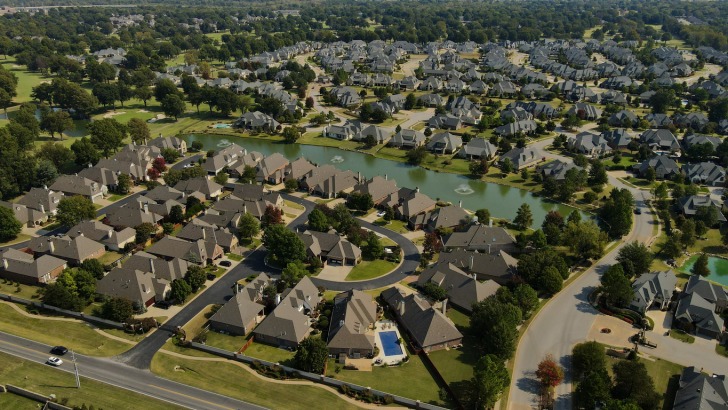
Pros and Cons of Living in Tulsa, OK – Summary Table
| Pros of Living in Tulsa | Cons of Living in Tulsa |
|---|---|
| 1. Mid-Size Charm | 1. Small Town |
| 2. Diverse Cultures | 2. Concerning Crime |
| 3. Low Cost of Living | 3. Economic Diversity |
| 4. Artistic Hotspot | 4. Weather |
| 5. Festivals and Music | 5. Taxes |
| 6. Outdoor Activities | 6. Limited Healthcare Specialization |
| 7. Advanced Education | 7. Public Services |
| 8. Employment Options | 8. Traffic Congestion |
| 9. Slower Pace | 9. Air Quality |
| 10. Flavorful Delights | 10. Slower Pace |
Tulsa Safety Overview
READ THE FULL REPORT: Tulsa Safety Review
Safety Index: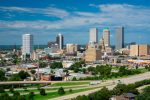
- OVERALL RISK: MEDIUM
- TRANSPORT & TAXIS RISK: LOW
- PICKPOCKETS RISK: LOW
- NATURAL DISASTERS RISK: MEDIUM
- MUGGING RISK: LOW
- TERRORISM RISK: LOW
- SCAMS RISK: LOW
- WOMEN TRAVELERS RISK: LOW
Frequently Asked Questions
What is the median age in Tulsa, OK?
Tulsa is a young city.
The average age of residents is 35 years old.
What is the average salary in Tulsa, OK?
Tulsa’s workforce is slowly diversifying.
Vocational industries, manufacturing, and healthcare are some of the leading employers.
The average salary in Tulsa is roughly $49,500—employment options throughout the city range from $36,000 to over $75,900.
Does Tulsa, OK, have a baseball team?
Tulsa’s favorite Double-A team, the Tulsa Drillers, is an affiliate of the Los Angeles Dodgers.
One step away from National League play, the Tulsa Drillers make their home in Downtown’s Greenwood District at ONEOK Field.
Does Tulsa, OK, have a Children's Museum?
A highly regarded interactional museum, The Tulsa Children’s Museum features play-centric exhibits combining knowledge and imagination.
What University is near Tulsa, OK?
Tulsa has nine universities, including the University of Tulsa.
Highly respected, this research university was founded in 1894.
Its undergraduate and graduate programs focus on science and technology.
Another famous university in Tulsa is Oral Roberts University, a private Christian institution.
